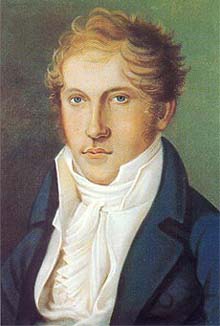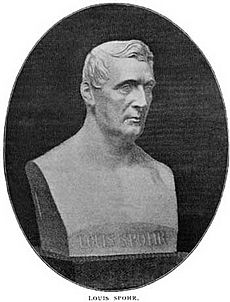Louis Spohr facts for kids
Louis Spohr (born April 5, 1784 – died October 22, 1859) was a famous German composer, violinist, and conductor. During his life, many people admired his music. He wrote ten symphonies, ten operas, eighteen violin concertos, and many other pieces.
Spohr was also an inventor! He created the violin chinrest, which helps violinists hold their instrument comfortably. He also invented rehearsal marks for orchestras. These are letters placed in music scores to help musicians find their place quickly during practice.
Even though he was very popular when he was alive, his music was not played as much after he died. But in recent years, people have started to discover and enjoy his music again, especially in Europe.
Contents
Life of Louis Spohr
Spohr was born in Braunschweig, Germany, in 1784. His family moved to Seesen in 1786. His parents loved music: his mother was a good singer and pianist, and his father played the flute. Spohr started learning the violin from a teacher named Dufour. He began trying to compose his own music in the early 1790s.
Dufour saw how talented Louis was and told his parents to send him to Brunswick for more lessons.
In 1799, Spohr tried to go on his first concert tour to Hamburg, but it didn't go well. He asked Duke Karl Wilhelm Ferdinand of Brunswick for help. Spohr played a concert for the Duke, who was so impressed that he hired the 15-year-old as a musician in his court.
In 1802, the Duke helped Spohr become a student of Franz Eck, another famous violinist. Spohr traveled with Eck to places like Saint Petersburg. Eck taught Spohr a new way to play the violin, and Spohr became very good at it. During this time, Spohr wrote some of his first important pieces, including his Violin Concerto No. 1.
After returning home, the Duke let him go on a concert tour in North Germany. In December 1804, he played a concert in Leipzig. A famous music critic, Friedrich Rochlitz, was amazed by Spohr's playing and his compositions. This concert made Spohr famous across Germany almost overnight.
Family and Career
In 1805, Spohr became the concertmaster (the lead violinist) at the court of Gotha. He stayed there until 1812. In Gotha, he met Dorette Scheidler, an 18-year-old harpist and pianist. They got married in 1806 and were very happy together.
Louis and Dorette often performed as a violin and harp duo. Spohr even wrote a special piece for them, the Sonata in C minor for violin and harp. They toured in Italy (1816–1817), England (1820), and Paris (1821). Later, Dorette stopped playing the harp to focus on raising their children. She passed away 28 years after they married.
In 1808, Spohr practiced music with the famous composer Ludwig van Beethoven. Spohr wrote that Beethoven's piano was out of tune and that Beethoven played a bit roughly.
Spohr worked as a conductor in Vienna from 1813 to 1815, where he remained friends with Beethoven. He then became an opera director in Frankfurt from 1817 to 1819. This allowed him to put on his own operas, like Faust, which had been turned down in Vienna.
His longest job was from 1822 until his death. He was the music director at the court of Kassel, a position he got thanks to the suggestion of another famous composer, Carl Maria von Weber. In Kassel, in 1836, he married his second wife, Marianne Pfeiffer. She lived many years after him, until 1892.
In 1851, Spohr had some trouble with the Elector (a ruler) of Kassel. The Elector wouldn't let Spohr take a two-month leave he was allowed. When Spohr left anyway, part of his salary was taken away. In 1857, he was forced to retire, even though he didn't want to. Later that year, he broke his arm, which meant he couldn't play the violin anymore. However, he still conducted his opera Jessonda in 1858. He died in Kassel in 1859.
Spohr was also a Freemason, like other famous composers such as Joseph Haydn and Wolfgang Amadeus Mozart. He was also a dedicated violin teacher and taught about 200 students, many of whom became well-known musicians.
Louis Spohr's Works
Louis Spohr wrote over 150 musical pieces with opus numbers, and nearly 140 more without them. He composed music for almost every type of musical group.
His nine symphonies show how music changed from the Classical style to program music (music that tells a story or describes something). For example, his sixth symphony shows different musical styles from the past to his own time. His seventh symphony uses two orchestras to represent "sacred and secular in human life." His ninth symphony is called Die Jahreszeiten (The Seasons).
Between 1803 and 1844, Spohr wrote more violin concertos than any other composer of his time – eighteen in total! Some of them are unusual, like his one-movement Concerto No. 8, which sounds like an opera song. This piece is still played by famous violinists today, like Jascha Heifetz and Hilary Hahn. He also wrote two concertos for two violins.
Spohr's four clarinet concertos are very popular with clarinet players. He wrote them for a talented clarinet player named Johann Simon Hermstedt.
Chamber Music and Operas
Spohr wrote a lot of chamber music, which is music for a small group of instruments. He composed 36 string quartets (for four string instruments) and four double quartets (for two string quartets). He also wrote other pieces for duos, trios, quintets, sextets, an octet, and a nonet. He wrote music for solo violin and solo harp, and pieces for violin and harp that he and his wife Dorette played together.
Even though they are not as well-known today, Spohr's operas like Faust (1816), Zemire und Azor (1819), and Jessonda (1823) were very popular throughout the 1800s and into the early 1900s. Jessonda was later not performed in some places because its story showed a European hero falling in love with an Indian princess.
Spohr also wrote 105 songs and duets, many of which were collected in his Deutsche Lieder (German Songs). He also composed a mass and other choral works. While most of his operas were mainly known in Germany, his oratorios (large musical works for choir, soloists, and orchestra, usually based on a religious story), especially Die letzten Dinge (1825–1826), were very popular in England and America during the 1800s. This oratorio was translated into English as The Last Judgment.
Inventions and Teaching
Spohr was a very skilled violinist. Around 1820, he invented the violin chinrest, which is a small piece that attaches to the violin and helps players hold it comfortably with their chin. He was also an important conductor. He was one of the first to use a baton (a stick used to direct musicians) and he invented rehearsal letters. These letters are placed in the music so a conductor can tell the orchestra to start playing "from letter C," for example, which saves a lot of time during practice.
Besides his musical works, Spohr is also remembered for his Violinschule (The Violin School). This book taught many new violin playing techniques, like spiccato (a bowing technique where the bow bounces lightly off the strings). It became a very important book for learning the violin. He also wrote an interesting autobiography (a book about his own life), which was published after he died in 1860. There is a museum in Kassel dedicated to his memory.
Many people who lived at the same time as Spohr thought his best works were truly Romantic and influenced composers like Felix Mendelssohn.
Images for kids
-
Louis Spohr - Sei Still Mein Herz.ogg
1. Sei still, mein Herz
-
Louis Spohr - Zwiegesang.ogg
2. Zwiegesang
-
Louis Spohr - Sehnsucht.ogg
3. Sehnsucht
-
Louis Spohr - Wiegenlied.ogg
4. Wiegenlied
-
Louis Spohr - Das Heimliche Lied.ogg
5. Das heimliche Lied
-
Louis Spohr - Wach auf!.ogg
6. Wach auf!
See also
See: List of music students by teacher: R to S#Louis Spohr.  In Spanish: Louis Spohr para niños
In Spanish: Louis Spohr para niños



